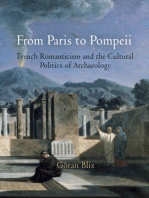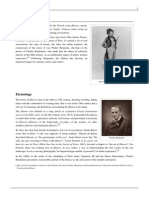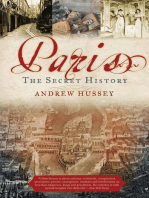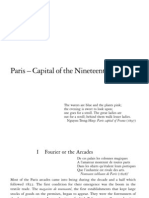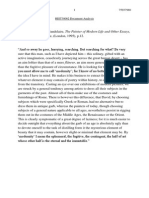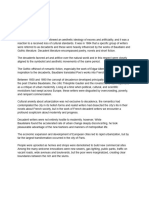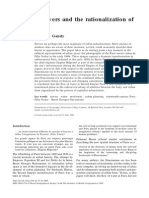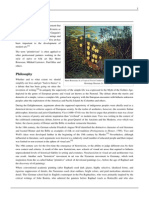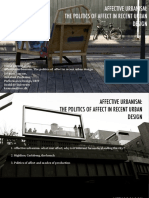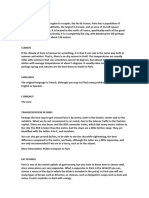World Cities
World Cities
Uploaded by
AnarchivistaCopyright:
Available Formats
World Cities
World Cities
Uploaded by
AnarchivistaOriginal Description:
Copyright
Available Formats
Share this document
Did you find this document useful?
Is this content inappropriate?
Copyright:
Available Formats
World Cities
World Cities
Uploaded by
AnarchivistaCopyright:
Available Formats
What is a World Capital of Culture?
The Case of Paris Kjetil Jakobsen
Paris invented the notion of modern art and that of the avant-garde. She exercised undisputed hegemony over modern art and literature from the midnineteenth to the mid-twentieth century, when New York stole the concept. Pioneering works of the 1930s like Roger Caillois Le mythe et lhomme and Walter Benjamins Passagen-werk indicated the existence of a secret generative link between the mythology of Paris as capital of modernity and the discourses of modern art and literature.1 The line of research was reopened in the 1990s and early 2000s in major studies by Patrice Higonnet, Christophe Charle, Pascale Casanova, Christopher Prendergast and Karlheinz Stierle.2 These writers are in intimate dialogue with some of the most important forms of cultural theory in the 20th century. Higonnet combines Roger Caillois theory of the mythology of the metropolis as frame for interpretation and action with Habermasian ideas of public space. Charle, a cultural historian and Casanova, a scholar of comparative literature, both draw primarily on the sociology of Pierre Bourdieu. Prendergast uses deconstructive approaches, tracing the readability and blur of a 19th century Paris stretched out between Paris the political and cultural capital, dominating its territory and Paris, the metropolis, network of cultural exchange. One type of cultural theory is lacking, though. A world capital of culture is a capital of mediation. It mediates worldwide and is mediated worldwide. Yet none of the above see the problem as one of media studies and media theory. Walter Benjamin was a pioneer in linking art theory and urban studies to the theory of the modern media. Karlheinz Stierle puts this aspect of Benjamins work into parentheses in order to re-appropriate the Passagenwerk for German philology and hermeneutics (Romanistik). I will try and understand the notion of a Paris world capital of culture also from the perspective of media history and media theory. Only thus can one grasp what was most productive in the relation between the discourses of Paris and those of the avant-garde.
1
Walter Benjamin, Das Passagen-Werk, Rolf Tiedemann (ed.), Frankfurt, 1983; Roger Caillois, Le mythe et lhomme, Paris, 1938. Translations are mine, unless otherwise stated. 2 Pascale Casanova, La Rpublique Mondiale des Lettres, Paris 1999; Christophe Charle, Les intellectuels en Europe au XIXe sicle: Essai d'histoire compare, Paris, 1996; Patrice Higonnet, Capital of the World, Arthur Goldhammer (transl.), Cambridge Mass., 2002; Christopher Prendergast, Paris and the 19th Century, Oxford, 1995; Karlheinz Stierle, Der Mythos von Paris: Zeichen und Bewusstsein der Stadt, Mnchen, 1993. 45
What is a world capital of culture?
The surrealists: Debunking bourgeois modernity To contemporaries, Haussmannian Paris with its broad and well ordered streets was the capital of modernity. The Parisian exposition universelles dazzled the world every eleven or twelve years. Paris invented the grand magasins and the fashion industry, and led the world in the development of advertising and the commercial press. Though utterly useless, the Eiffel-tower (1889) was long the highest building in the world and a brilliant example of engineering skill. It symbolized also Paris claim to be the capital of modernity. Modernity always frightens the moderns, and so did Paris. She was known in the mid 19th century as the capital of crime and the tales of foreign travellers to the big city oscillate between fear and delight.
Illustration 1: Gustave Caillebotte, Paris street, Rainy day, 1877, Chicago Art Museum. Haussmannian modernization was controversial but the scale and vision of the project inspired awe. The modernism of it is easily overlooked in an age when the city of on the Seine, has become a capital of nostalgia. The Paris of today is
46
Kjetil Jakobsen
still largely a creation of Napoleon 3 and his team of modernizers, notably Haussmann, the prfet. Yet we see it through the eyes of the impressionists whose dreamy, sensuous visions ran counter to Haussmannian modernity. In order to appreciate the clarity, functionality and readability of Hausmannian Paris one should rather, as Higonnet points out, take a look at the paintings by Gustave Caillebotte (ill. 1). Haussmans Paris participated in a transition from representative to a functional public. It expressed power, but with infrastructure of communication rather than with monuments.The symbol of power was not the monument but the corridor of traffic, the grand boulevard or the railroad. The ancient city on the Seine became, in a generation, the city of light, of readability, cleanliness and fluid communication. A generation earlier, Balzac, the novelist, had dreamed of stopping the chaotic movement of the metropolis and re-establish a static catholic order. Haussmann, however, was as obsessed with movement as with legibility. His cityscape made movement and even contingency legible. The universal exposition of 1937 and its relative failure offered the occasion to reflect upon the standing of Paris in the world. The great surrealist critic Roger Caillois published Le mythe et lhomme in 1938. This contained an important essay on the mythology of Paris. Caillois proposed a brilliant and long unfulfilled research program of investigating the relation between the city in the text and the text in the city. Caillois distinguished the mythic from the phantasmagorical. Myth provides structure to the quotidian, helps us make sense of our everyday lives.3 Unlike the phantasmagorical, the myth is real, it organizes the way reality is perceived by restraining the field of possible representations. There exists [] a representation of the big city, exercising such power over the imagination that the question of whether it is exact or not is in practice never asked. Though every bit of it has been created by literature, it has entered the collective mental atmosphere, thus exercising a certain power of restraint.4 Mythologies, like the mythology of modernity or the closely related mythology of Paris are too potent to be either true or false, claimed Caillois. Created in the fictive universes of art and literature, the mythologies are at work in society, inciting to action. Paris has been the character of a thousand novels. Every man or woman who sees Paris for the first time is, knowingly or not, guided in his interpretation by the stereotypes of art. Octavio Paz explains in an autobiographic work how discovering Paris for the first time in the 1940s was for him rather a recollective process, being
3 4
Caillois 1938, p. 149. Op.cit., p. 156. 47
What is a world capital of culture?
confronted at every unknown corner with memories of books read and places imagined.5 Caillois research program was a profoundly original one, promising to release the sociology of literature from the unproductive opposition of idealism versus materialism, or as we should perhaps say today, close reading versus externalism. Yet the paradoxical idea that Haussmannian Paris and modernity could be thought of as mythologies belonged to a common stock of thought in the surrealist movement. Only as the mythology of Paris capital of modernity was disintegrating did it become apparent that it had indeed always been a myth. In the interwar years Paris was losing its un-canniness, becoming a preferred target of family tourism, safe haven of middle class taste. The metropolis was going tame, like a captive beast. The boulevards, seven story apartment buildings and grands magasins of Paris were being replaced as icons of modernity by the skyscrapers of Manhattan and Chicago. As Haussmannian civilization denaturalized, its discourse of nature was deconstructed. In his famous 1924 essay on the Butte au Chaumont parc. Aragon ridiculed the bourgeois sense of nature. He thus indirectly ridiculed what remains the most undisputed achievement of second empire reform; the transformation of the overcrowded and dirty city into what could be seen as an Arcadia of green parks.6 Though modernist in tune and rhetoric, the surrealists indulged, at times, in nostalgia for pre-haussmannian Paris, as in the praise for the work of Atget, the photographer who documented vieux Paris with paradoxical scientific precision. At their best they had a sharp eye for the historicity of modernity. To the young Aragon a modern city is a successive layer of mythologies of modernity. The city is constantly changing, one materiality of desire replacing another. It is an archaeology of dreams and has become the unconscious of modern man. Aragon wrote that the metaphysics of places (lieux) had re-placed (!) the metaphysics of the gods (dieux): Metaphysics of places, it is you who rock the childrens cradle and people their dreams.7 Delving into the cityscape the observer founders the abysses of the soul. In another of the essays that became part of Le paysan de Paris, Aragon celebrates the Parisian arcades, relics of early 19th century modernity condemned to demolition by city developers. A powerful image of the historical unconscious is developed. The singular light of modernity [] rules bizarrely in the kind of covered arcades that
5 6
Quoted in Casanova 1999, p. 48. By 1870 there were roughly 4500 acres of municipal parkland as against only 47 acres 20 years before. Prendergast 1995, p. 9. 7 Louis Aragon, Le paysan de Paris, Paris, 1926, p. 19. 48
Kjetil Jakobsen
abandon in Paris in the area around the grands boulevards and that are known, disturbingly, as passages, as if, in these corridors depraved of the light of day, no one is allowed to halt more than an instant.8 The young writer clothes his metaphor in a lovely and mostly tacit play of language. The steel and glass arcade, known in French as passage is said to be ephemeral, a place where one is condemned to movement. It is a place for passengers (passagers) in passage. In the passages passers-by make passes at each other. The passages are favourite locations of the maisons de passe (sex motels, brothels). Here rationality and instrumentality turns burlesque and grotesque as relations of desire and money condense. Built to flow with time and be contemperous, the passages are now of the past (pass). They have, writes Aragon, become human aquariums where dreams and life forms of another poque have been artificially conserved. The passer-by of the passage has no time for reflection. Yet as the observer delves into its non visdom (pas sage), a wise land (pay sage) of the city landscape (paysage) opens up. In the late 1930s Walter Benjamin, political refugee from Hitlers Germany, took pauses off his studies in the Biblioteque nationale in the rue Richelieu, strolling the arcades of the second arrondisment, taking notes for a planned work on Paris as cultural capital of the 19th century. Like Caillois at the same time, Benjamin developed surrealist thought into something like a new approach to the study of culture. He explored the material indexes and psychic effects of the advent of modernity, with an eye for discontinuity in history, tracing various modernities. He took up to new consideration both the urban flaneur and the shock aesthetics of Charles Baudelaire, linking it to his own reflections on the mass media and the decline of the aura. In Benjamin, the surrealist theme of the historical unconscious and the dreamlife of the objects was wedded to Marxist materialism. He set out to explore the dreamlife of objects. He read the 19th century presentations of Paris as dreamtexts, seeing the metropolis as a necropolis of dead desires and forgotten wishes. In the work of Benjamin and the surrealists, Haussmannian Paris, widely considered as the quintessence of bourgeois urban rationality, was transformed, transfigured and deconstructed. Benjamins friend Sigfried Krackauer digged out some the more bizarre and exotic aspects of this culture in his seminal study on Offenbachs Paris. The surrealist deconstruction of Hausmannian modernity was once again a case of Minervas owl flying at dusk. As Benjamin took his notes, Paris was no longer the undisputed cultural capital of the world, The age of Parisian hegemony was
8
Aragon 1926, p. 21. 49
What is a world capital of culture?
ending. It ended in June 1940 with the troops of the Wehrmacht parading on the Champs Elyses. Why Paris? At first sight it comes as no surprise that the avant-garde of art and literature were associated with the self-proclaimed capital of modernity. It was Henri de Saint-Simon, the founding philosopher of technocracy, who first used the word avant-garde in something like its modern meaning.9 Saint-Simon stressed the importance of artists to industry and called for an art that praised and inspired industrial and scientific progress. Incidentally the Saint-Simonians were the major intellectual force in the modernizing program of the Second Empire. And yet the actual Parisian avant-garde was very different from the one dreamt up by Saint-Simon. The Surrealists were not the first group of experimental artists to be severely critical of Haussmannian modernity. Baudelaire makes a mockery of the dream of the eminently readable city. The symbolists of the 1880-s and 90-s despised it. And yet the mythologies of Paris and of the avant-garde are interwoven. It should come as no surprise that Europes largest urban conglomeration has played an important role in the production and reception of its experimental art. Kenneth Clark points out that: The history of European art has been, to a large extent, the history of a series of centres, from each of which radiated a style [] which was metropolitan at its centre, and became more and provincial as it reached the periphery. [] It may be said that provincialism is merely a matter of distance from a centre, where standards of skill are higher and patrons more exacting.10 And yet the importance of Paris to modern art and literature is out of all proportion to its population and its economic and political importance. It is not just that most of the key avant-garde movements originated in Paris or that many of the most famous interventions took place here. What is to count as avantgarde is always a matter of perspective. The point is precisely that the power to define what was avant-garde was concentrated in Paris, owing to a position of cultural hegemony. The novels of Kafka or Faulkner might be written outside of
9
Ghita Ionescu, The political thought of Saint-Simon, London, 1976. Quoted in Franco Moretti, Atlas of the European Novel, 1800-1900, London & New York, 1998, p. 164.
10
50
Kjetil Jakobsen
Paris, but it took Parisian consecration for them to be redefined and appreciated as avant-garde.11 Why did the discourse of the avant-garde emerge and flourish in Paris? The Bourdieu-school has taught us not to short circuit from the specialized world of art and literature to very general political and economic phenomena. Politics and economics are important to art, but only as mediated through the specific logics of the field of cultural production. The immediate context of the avantgarde was not politics, business or industry but culture and its institutions. The historian and historical sociologist Christophe Charle argues that the emergence of the avant-garde was part of a general hegemony in cultural production. To put it briefly: Paris dominated high culture, because she dominated culture in general, also low culture. Paris concentrated more newspapers and theatres, more fashion industry than Berlin, Vienna or St. Petersburg. Also there were more art dealers, editors, books, students and professors and teachers than in any other European city. The only real challenger was London. Though trailing Paris somewhat as a centre of cultural production, London in the 19th century was a larger and wealthier city. Considered as a capital of arts, London suffered from two defects. Firstly the English did not translate. In the mid 18th century roughly 20% of published works of fiction in England were translated, 100 years later that proportion had fallen to only 5%.12 Today it stands at 3%.13 In France the proportion has for centuries remained stable at about 15%. In Berlin and Vienna almost half the published works of literature in the 19th century were translations. London was the undisputed cultural centre of the British empire and of the English speaking world. Yet, if we accept David Damrosch definition of world literature as writing that gains in translation,14 then London was not a capital of world literature. It was not truly a world capital of culture as it responded only belatedly to developments beyond the language barriers. Secondly religion was much more of a factor in London. The protestant heritage added an austere feel to social life. One could amuse oneself in London, but it was not a capital of the good life. Thophile Gautier observed that Protestantism is as inimical to the arts as Islam, perhaps more so. Artists can only be pagans or Catholics.15 Lord Acton countered that Culture corrupts, but French culture corrupts absolutely.16 Protestantism as practiced in England was destructive not only to
11 12 13 14 15 16
Casanova 1999. Moretti 1998. Casanova 1999, p. 231. David Damrosch, What is world literature ? Princeton, 2003, p. 289. Quoted in Patrice Higonnet, Capital of the World, Cambridge Mass., 2002, p. 241. Quoted in Higonnet 2002, p. 341. 51
What is a world capital of culture?
experimental lifestyles but also to the freedom of artistic expression. The liberty of political expression was well developed in London, but artistic expression was poorly protected, less so, than in imperial Germany and perhaps also than in tsarist Russia. mile Zola, a major public figure in France, was outlawed in London throughout most of his life, not for his politics but for the supposed indecency of his writings. As late as in 1889, the publisher Vizetelly was sentenced to three months imprisonment for having published a translation of Zolas La Terre. In the 1890s Oscar Wilde was pursued, imprisoned and driven into exile, to Paris.
So what was the mythology of Paris? Charle may be right that the hegemony of Paris in late 19th and early 20th century avant-gardism stands in need of no further explanation. Paris dominated high culture because she dominated low culture. Yet the predominantly quantitative approach of Charle tells us little of why the discourses of the avantgarde came out as they did. Today, when the contingency of the Parisian conception of modern art and literature, grows more obvious by the day, it becomes even more urgent to explain why this discourse triumphed and remained hegemonic for so long. In order to understand the discourses of the avant-garde we need to sort out the key chronological layers of the mythology of Paris. On the most general level, the signification was Paris = capital of modernity. This worked as a kind of self-fulfilling prophecy. As long as the world believed that Paris was the capital of modernity, she had the power to impose upon the world a series of discourses of modernity. As late as the 1970s she even had the power to proclaim the advent of post-modernity. Paris was thus the symbolic capital of a wide range of modernities. Modernity is perhaps best defined as the power to bestow universality on that which is now, but what is perceived as universal in one discourse may not be so in a different one. A universalized present has a story to tell about itself. Thus each modernity will generate a story of modernity, of how modernity, the modern, modernism, or whatever it calls itself, appeared and developed etc. I cannot here examine the nature of the notion of modernity, but will assume instead a position of second or third order observation, observing some aspects of the self-observation of Parisian modernity. Callois and Benjamin both date the emergence of the mythology of Paris as capital of modernity to the 1840s. They explain it by linking the industrial revolution and the rising the threat of the industrial proletariat to the emergence
52
Kjetil Jakobsen
of new genres of literature. Their key witness is actually Charles Baudelaire and the urban prose poem. But they throw Baudelaires work into context by focusing on Haussmannian urban reform as well as on the mythology of Paris that emerged in popular literature from around 1840 and onwards. Caillois links the mythology of Paris to the shift from the novel of adventure in the tradition of Fenimore Cooper to the detective story in the tradition of Eugne Sues Mystres de Paris. With the advent of the detective story, there is no need to travel to encounter mystery. The big city harbours another ghostly side, a night side, dark and dangerous. The world of sublime grandeurs and inexpiable failures, of unbroken violence and mystery, where at any moment anything is possible anywhere because the imagination has lavished upon and invested in it the most extraordinary attention that world was no longer remote, inaccessible, and autonomous; it was the world in which everyone spends his life.17 According to Caillois the discourse of the detective story tacitly plays on bourgeois fears of the working class. He points out how Paris as text and texts of Paris wove seamlessly into one another in the popular works of Victor Hugo and Alexandre Dumas. The popular novel of the 1840s develops the modern myth of Paris as a site of adventure for the solitary hero. The most important witness to the privileged and secretive relationship between Paris and its literature is Baudelaire. Methodologically Caillois focuses on the identity between the city in the text and the text in the city. Unlike Benjamin, he fails to see, how the allegorical genius of Baudelaire actually cracked open a fissure between the city as text and the city in the text. A key effect of the allegorical imagination is that it makes felt both the signifying power of the city and the difference between the city and its literature. Baudelaire is important because he is the obvious junction between the two sets of mythologies, Paris and that of modern art and literature. And yet, as contemporary historians see it, the mythology of Paris originated much earlier. The Caillois/Benjamin emphasis on the rise of the industrial proletariat is symptomatic of interwar preoccupations. Higonnet and Stierle focus instead on the mid 18th century. The mythology of Paris as capital of the contemporary, originated, they claim, rather suddenly in the latter phase of enlightenment culture.
17
Caillois 1938, p. 154. 53
What is a world capital of culture?
Capital of the republic of letters Paris is an old city. Numbering about 200 000 people in the 13th century it was perhaps already the biggest city in Europe. La Sorbonne was the center of scholastic philosophy. Thomas Aquinas, Bonaventura and Ablard taught here. Yet for a long time Paris was not mythologized. Unlike Rome, Venice, Florence or London, the city of Paris appears only sporadically in medieval or renaissance literature and art. The medieval and early modern art and literature that has come down to us was mostly a culture of kings, lords and churchmen. Besides being a centre of scholastic learning, Paris was rather a popular place, a city of crafts and commerce. The French kings and their court of noblemen mostly avoided the smell and noise of the city. Paris thrived in her own way, disregarding of the classical ideals for urbanism, notably of the notion of the city as a well ordered micro-cosmos. In the great century French cultural production centred on the court at Versailles as well as the equally bucolic monastery of Port Royal. Pascal and Racine belonged to the Port Royal circle, while Molire and Lully entertained the court at Versailles. As long as the sun king lived, the ultra-modern splendour of Versailles easily overshadowed the ancient and populous city of Paris. Then in the middle of the eighteenth century things changed as Paris became the capital of the republic of letters. Suddenly it was the republic of letters that set the tune, the court at Versailles hesitantly copying the fashions of the Parisian salons and cafs. The heroes of the new republic were the philosophes with their radical ideas. 59 % of the contributors to the Encyclopdie lived in Paris. As seen through the eyes of the philosophers, Paris become not only to Parisians or Frenchmen but to the entire European world, the preferred seat of modern life. Paris became the capital of that first selfconscious movement for meliorism and modernization; the enlightenment. The Enlightenment took the first steps towards a new discourse of urbanism that valued the multitude, contingency and dynamics of the big commercial and industrial city, disregarding the classical urban ideals of the nobility. In the works of Rousseau, Diderot, Mercier and La Bretonne, there develops a marginal and personal regard on Paris. The notion of the city as a well ordered micro-cosmos are left behind. Paris becomes multifarious and disquieting, and is celebrated as a place for the new and the unexpected, for freedom and loneliness. What happens is not only that Paris becomes aware of itself as a major centre of cultural production. In the writings of the latter enlightenment, a new selfreflective sense of the modern becomes apparent. Modern man for the first time becomes conscious of himself as such and this consciousness expresses itself as a Parisian experience. This experience of modernity is by no means uncritical. It is
54
Kjetil Jakobsen
modern precisely in terms of the way the writers were able to self-reflectively criticize the civilization in which they participated. Jean Jacques Rousseau is the extreme case. The citizen of Geneva spent most of his life in Paris, a lonesome and distrustful wanderer in the centre of the modern world, hopelessly fascinated by what he abhorred. His bitterness is expressed in miles famous adieu to the big city: Adieu donc Paris, ville clbre, ville de bruit, de fume et de boe, o les femmes ne croyent plus lhonneur ni les hommes la vertu.18 Yet, Emiles farewell to Paris is not just a rebuke; it is also a tribute to the capital of selfreflective critique. For who would want to live in a place where people are so ignorant as to trust in the virtue or honour of the opposite gender? The sudden shift in cultural hegemony, from bucolic Versailles to urban Paris was tremendously consequential. From the moment Versailles copied Paris rather than the other way round, the downfall of the ancien regime was inevitable. The capital of the republic of letters would soon be the capital also of a political republic. But why did the mythology of Paris, capital of modernity begin with Paris capital of the republic of letters? The philosophers were a group of publishing writers, oriented towards the book market, the first such group ever. Voltaire was the first professional writer in France, living, not of patronage but of the sales of his books. Malesherbes wrote that the philosophes are to the people dispersed what the orators of Rome and Athens had been to the people assembled.19 The philosophers were the stars and the focal points of two major cultural institutions that developed in Paris around this time; the salon and the caf. Paris became precisely a capital of letters, the site of writers, printers, editors and newspapers. In a Habermasian perspective one could say the representative public of Versailles gave way to the reasoning public of the Parisian caf and salon. This assumes that the cafs and salons centred communication in a way that was similar to what the court had done. But did the printed word reflect the discussion of the bourgeois public of the cafs and salons. Or it was the other way around? Perhaps the cafs and the salons originated as specific re-territorializations of the new de-territorialized and decentred forms of social life brought on by the printed word.20 The Parisian salons and cafs and their mythologies were certainly dominated by the printed word.
18 19
Quoted in Stierle 1993, p. 92. Quoted in Higonnet 2002, p. 30. 20 On the play of re-territorialization and de-territorialization see Gilles Deleuze and Flix Guattari, A Thousand Plateaus: Capitalism and Schizophrenia, Brian Massumi (transl. and foreword), Minneapolis 1987. 55
What is a world capital of culture?
Illustration 2: Anicet Charles Gabriel Lemonnier, A Reading in the Salon of Mme Geoffrin, 1812, oil on canvas, 129 x 196 cm, Chteaux de Malmaison et BoisPreau. Salons and cafs were perceived as places to write and to read, inert or aloud. Lemmoniers famous painting of Mme Geoffrins Salon is perhaps not the best of sources by the standards of traditional historiography, having been painted a generation or two after the facts. But precisely because it mythologizes its subject matter, A Reading in the Salon of Mme Geoffrin gives us a privileged entry to the discourse of Paris, capital of the republic of letters. We see Les lumires as perceived by an admiring, immediate posterity. Fontenelle, Montesquieu, Diderot, Marmontel and other figures of the Enlightenment gather round a bust of Voltaire to hear a reading of his LOrphelin de la Chine. Neo-McLuhian social theorists like Friedrich Kittler or Niklas Luhmann stress that the social reality of modernity is a mass mediated one.21 Aristocratic society was a rhetoric of the human body. Power was to be expressed in the persons present at court, in the form of interaction. In modernity people still interact of course, and interactions still matters. But interaction no longer encompasses social power or reality.
21
Friedrich Adolf Kittler, Aufschreibesysteme: 1800/1900, Mnchen, 1987; Niklas Luhmann, Social systems [Soziale Systeme. Grundriss einer allgemeinen Theorie], Bednarz & Baeker (transl.), Stanford, 1995 [1984]. 56
Kjetil Jakobsen
The gap between interaction and society has become unbridgeably wide and deep []. Society although, although largely existing as interaction, has become inaccessible to interaction. No interaction, however, highly placed the participants may be, can claim to be representative of society. Consequently there is no longer a good society. The spheres of experience accessible in interaction no longer provide the societally necessary knowledge; if anything they systematically lead one astray.22 In Versailles under Louis XIV, interaction and society coincided, for the last time. The monarchy and the aristocratic class exist as concrete relations, modern society conceives of itself in the form of mass mediated communication. As Benedict Anderson has shown the bourgeois class of the 18th century conceived of itself through the intermediation of newspapers and novels, allowing people to see themselves as part of an imagined community.23 The transition of cultural hegemony from Versailles to Paris was part and parcel of the birth of modernity. Between the 17th century court and the 18th century salon and caf an epistemological break occurred. And yet people think place even if after its deplacing. Even disembodied communication is thought of as embodied. Deterritorializaition succeeds through re-territorialization. The de-terriorialization of the arts and the letters also involved their re-territorialization on Paris and a new set of institutions. One could say, in a contemporary language, that the institutions of salon and caf functioned as a kind of simulacra that lend meatspace to what now really mattered, the virtual reality of letters. Mythologies of modernity The philosophers were resolutely pro-scientific. The revolution and Napoleonic reform anchored science in technological universities (coles polytchniques) and French science took on a distinctly practical orientation. The century from the mid 18th to the mid 19th, from Lavosier to Daguerre, was the golden age of French science and technology. The bottom line of the Paris = capital of modernity discourse was Paris = capital of reason and rationality. On the discursive marked for national mythologies the rationalism of the French was opposed to the empiricism of the English, the pragmatism of the Americans and the idealism of the
22
Niklas Luhmann, Social systems, Stanford. Translated by Bednarz og Baeker [Soziale Systeme. Grundriss einer allgemeinen Theorie 1984] 1995, p. 430. 23 Benedict Anderson, Imagined Communities. Reflections on the Origin and Spread of Nationalism, London, 1983. 57
What is a world capital of culture?
Germans. The first half of the 19th century marked the rediscovery of the Rne Descartes and his canonization, in works by Victor Cousin and August Comte, as a kind of founding father of French thought. Focusing on Paris, French national identity took on a paradoxical structure, it conceived of itself as the land of rationality and universality. The canonization of Descartes pointed at a way of reconciling faith in modern science and rationality with a new individualist self. As capital of the modern self, Paris did however generate far richer notions of the self than the Cartesian one. The individualism of the enlightenment was not opposed to civic duty, it was united to it by human reason. In the writings of Baudelaire on the man of modernity a new form of individualism appeared, the denatured and alienated self, bored and marginalized in the midst of triumphant modernity. The theme of alienation was, by the way, developed philosophically in the early 1840s in the Parisian manuscripts of the still very Hegelian Karl Marx. The rationalism of the philosophers led via the small scale Machiavelism of Balzacs Rastignac to the hedonism of Gay Paris, celebrated by the 19th century entertainment industry. This hedonist self underwent a striking change of gender. Starting out in 1750 as capital of male rationality and individualism , Paris had by 1900 become the capital of female subjectivity and desire. The porte monumentale of the World exposition of 1900 was crowned by a statue of La parisienne, described by Higonnet as chic, emancipated, wilful, and faintly perverse, an odd mix of Sarah Bernhardt and Delacroixs Goddess of Liberty.24 Paris had become the capital of female individualism. This was for long time expressed negatively as in the rampant discourse on la parisienne as debauche (sinful or perverted) and Paris as capital of prostitution. By the turn of century the tune had changed, and in a way that was not without connection to the discourses of the avant-garde and the bohmes. The sexually liberated and independent woman achieved a paradoxical respectability as muse of artists. In the year 1900 the world hummed to Gustave Charpentiers tremendously successful opera Louise in which the heroine proudly proclaims Paris ! Paris, Splendour of my desire, carry me away by the flap of a wing. Louise leaves her family to live as reine de la bohme in Montmartre. Paris became associated in a peculiar manner with the discourses of female desire. It became the capital of fashion, capital of beauty and not the least capital of romantic love. Strikingly London remained the capital of male fashion. Paris won on all other fronts as capital of pleasure. In Paris the notion cuisine moderne actually took hold before that of art moderne. Massialots Le cuisinier royal et bourgeois from
24
Higonnet 2002, pp. 35051. 58
Kjetil Jakobsen
1691 was republished in 1748 as Le nouveau cuisinier royal et bourgeois, ou cuisine moderne.25 Capital of revolution In the first half of the 19th century French philosophers like Benjamin Constant and Victor Cousin introduced the aesthetics of Immanuel Kant, coining the slogan Lart pour lart in the process.26 Starting from the discourse of lart pour lart Baudelaire proposed a poetics of modernity, coining the noun modernity (la modernit) in the process. From Baudelaire developed the discourses of avantgardism and modernism. The discourse of the Parisian avant-garde originated partly in art and literature, but it thrived best in what we would today call media discourse, in tourism and mass entertainment, precisely the forms of expression which modern art sought to distinguish itself. And yet the mythology of Paris and the discourse of the avant-garde formed for a century a discursive network of tremendous power and energy. The mythology of Paris as capital of rationality, pleasure, fashion and novelty was at work in high art and literature as much as in the entertainment industry which disseminated it. And yet it was neither specific of nor essential to avantgarde discourses. There is no direct line from high to low, even though the Parisian cultural industry constituted, a set of cultural resources which the avantgarde could deturn to its purposes. But one strain in the popular myth of Paris had direct implications for avant-garde discourse: Paris capital of revolution. This goes back to 1789, but of course in 1789 nobody knew that they were participating in the great French revolution. The discourse of revolution sprang forth in the 19th century especially in connection with the relatively undramatic regime change of 1830. Like countless governments since, that of Louis Phillippe attempted to conciliate the nation around an inclusive revolutionary mythology. The place de la rvolution where Louis VIX had been guillotined in 1793-94 was renamed Place de la concord.
25 26
Higonnet 2002, p. 295. In his diary for February the 11th 1804 Constant noted: Lart pour lart, et sans but; tout but dnature lart. Mais lart atteint au but quil na pas, after Ruff, in Charles Baudelaire, uvres compltes, Paris, 1968, p. 11. In his Cours of 1818, Victor Cousin proclaimed : Il faut de la religion pour la religion, de la morale pour la morale, de lart pour lart. Jean-Paul Sartre, L'Idiot de la famille II, Paris, 1988 [1971], p. 1491. 59
What is a world capital of culture?
Illustration 3: Eugne Delacroix, 1830, 260 325 cm, oil on canvas Louvre, Paris. The notion of revolution is a structuring one in the discourse of modern art and the avant-garde which developed in late 19th century Paris. Every artist or generation of artist is expected to revolutionalize the field. Revolution is the modern mythology par excellence, it is real through and through, inciting men and women to dramatic action. The revolution of 1789, crystallized into mythology by July monarchy artists like Hugo and Delacroix, provided the model for the peoples spring of 1848 as well as for the commune of 187071 and for the great political turnovers of the 20th century. Revolution is a fabulous instant of the interplay of de- and re-territorialization. As world capital of revolution the city of Paris is present in every political discourse anywhere in the world. In Delacroixs painting the Parisian communard, fighting on the pavs of the ancient city, is the avant-garde of progress. The humble communard, assisted by romantic art and the ideas of the enlightenment, is set to liberate all humanity. Parisian revolutions always remediate the citys past. Liberty Leading the People marries revolutionary fervour to the timeless wisdom and beauty of the Notre Dame cathedral (far right in the painting). As the city of revolution, Paris is a site of creativity and discontinuity but also of remembrance. This resembles closely the structure of modern art discourse where the artist is supposed to effect a kind of creatio ex nihilo while in reality working within a rather narrow
60
Kjetil Jakobsen
space of possibilities, a space defined by what his predecessors have done and by the hegemonic narratives of the field, narratives that define what is the status quo which is expected to be overturned. It is instructive to compare the structuring role of revolution in modern art to that of terrorism in media discourse.27 According to Luhmann media discourse is structured to encourage forgetfulness so that ever new information may take the scene. Info/non-info/unmarked space (the cognitive code which organizes the reality of the mass media) has a singular relationship to time. What is true or right or profitable today may very well be so tomorrow as well. But what is info today is invariably non-info tomorrow. Media discourse is forgetful, self-destructive and nervously creative. Every information is still born, turning into non-info the moment it is communicated. In media discourse one cannot stand still without falling into oblivion, one must run on towards ever new information.28 Revolution is an historical imagination; it purveys to change the course of history. Terrorism is instant history, that is no historical consciousness at all. Being designed to increase flexibility and create space for the new by enhancing forgetfulness, media discourse is like the generic city invoked by Rem Koolhaas.29 As discourse considered, modern art is rather like the city of revolution, negotiating the paradox of continuity through rupture, memory through creation. Even avant-garde art always invokes its past as it overturns it. As city of revolution Paris paralleled and enabled the discourse of modern art.
27
For an analysis of the cognitive structures of art discourse and media discourse respectively, see Niklas Luhmann, Die Kunst der Gesellschaft, Frankfurt a.M., 1995b; Niklas Luhmann, Die Realitt der Massenmedien, Opladen, 1996. 28 There is a difference between conveying information and using info/non-info as a cognitive code. Even if all communication carries some sort of information, only media discourse uses info as a code of second order observation, (re)-examining everything that happens with regard to whether it is information or non-information. In media discourse, every new piece information poses the question: What now? Information may thus be organized into narrative chains, driven onwards by suspension as to which information will follow next. This is a favourite strategy of entertainment (see Luhmann 1996). 29 The key to Koolhaas concept of the generic city is its ubiquitousness. The generic city' is a displacement to the urban periphery, a territory that can no longer be called suburbia, distorted and stretched beyond precedent, big enough for all, and with a remarkable ingenuity in avoiding urbanistic rules. [] The generic city is the city without history, without layers, superficial like a film studio, in a process of never ending self-destruction and renewal. This city is liberated from the captivity of the centre and of identity. Bo Grnlund, Rem Koolhaas Generic City and a modernist dilemma of urbanisation vs. urbanity in avantgarde architecture a recap of modernisms troublesome urbanism in the architectural sphere?, 1999 <http://hjem.get2net.dk/gronlund/Koolhaas.html>, not paginated. 61
What is a world capital of culture?
Paris, love story of la capitale culturelle with le capital culturel Of all the recent works that raise the question of the relation between the mythology of Paris and the discourses of modern art, Pascale Casanovas 1999 book La Rpublique mondiale des lettres is the most controversial and perhaps also the most original. She discusses modernism in terms of the centre-periphery structure of the global field of literature. The book originating as her doctoral thesis, supervised by Pierre Bourdieu, and draws much of its theoretical framework from the sociologist. Casanova has, however, clung to her identity as critic and scholar of literature. She sees the global field as a set of discursive power/knowledge practices in which literary works from around the world engage in reviews, translation, prizes, and in the informal exchanges and valuations of cafs and salons. Literature is thus conceived of as a global system of differences. Scholars of art and literature habitually reproach Bourdieu and his students for a sociological determinism supposedly inapt to grasp the uniqueness and autonomy of the work of art. A friendly reading will however distinguish a determinist reading of the social field from a more idiographic and interpretive approach to individual trajectories. The analysis of the social field is deterministic. A power of numbers or statistical determinism is thought to e at work on the macro-social level. Yet, Bourdieu often cites Spinozas idea that freedom is to know what determines you. Conversely an artist is never more unfree than when he claims to be free of all social determinations. In short the Bourdieu/Casanova (B/C) approach opens to the reflexivity of the creative artist studied. Casanova focuses on the migrs modernists, writers like Joyce, Beckett, Ibsen, Strindberg, Cioran, Fuentes, Kundera, Rushdie and Naipaul whose effort is stretched out between the peripheries in which they originated and the cultural metropolitans which consecrated their work. The emigrant writer is in a difficult if not impossible position, his work being measured by the incompatible aesthetics of the meridian and those of his native periphery. In order for his experimental work to be understood it must be translated and made available at the meridian. But in order to be translated at all he must usually gain recognition in a peripheral culture which does not value artistic experiment. But if the emigrant does surmount the odds, he is better placed than the hritiers of meridian literature when it comes to achieving a degree of reflexive autonomy relative to the art institution. This is because the emigrant knows both the structuring poles of the institution of literature. The artists of the periphery are locked up in their provincialism, while the autonomy of the metropolitans easily degrades in a paradoxical kind of provincialism. Only the emigrant knows the nature of art and literature in the global age.
62
Kjetil Jakobsen
According to the B/C approach, the truth of an author resides in his positioning in the global institution of literature. His positioning is his heteronomy. Why then does he engage in reflective autonomy? The reason is that literature is an institution for enhancing autonomy. It defines itself in direct opposition to the field of power as represented by the apparatus of the nation state, the mass media and the field of money (capitalism). Within literature the highest value is put on literary activity that is perceived to be autonomous of the political and commercial imperatives that are valid in society at large. The field of literature is indeed organized by the opposition between autonomy and heteronomy. In modern society, art literature included is an institution of liberty, yes it is in a paradoxical sense the institution of liberty. A modern society without autonomous art would be totalitarian. In literary life all secondary distinctions (those of class cultural capital included, and of nationality, race, gender, colonialism etc) blend into this primary distinction. Autonomy/heteronomy is furthermore a geographical axis, centred on what Casanova calls the (Greenwich) meridian, that is the great literary metropolises like Paris and London and the literary world languages with symbolic capital accumulated through the centuries (English, French, German). At the pole of heteronomy, on the other hand, one finds rural and social peripheries, small languages and minor literatures with little or no accumulated capital. Autonomy/heteronomy is also a temporal axis. The power to define modernity is located at the meridian. Thus a continuous stream of innovation goes from here and out to the smaller literatures and literary centres of the peripheries, not because the metropolitan artists are necessarily more creative, but because the metropolis is the centre of translation and consecration. The closer to the centre, that is the more accumulated symbolic capital there is in a text, the greater its literacy, the more modern and autonomous will be its form of expression. In the periphery, literature is a heteronymous activity closely tied in with the problems of national identity and other ethico-political problems. The notion of autonomous literature is suspect or even unknown. The relation to the meridian is receptive and imitative, one is concerned with following suit, absorbing the aesthetic innovations taking place at the meridian, but in a way that indeed allows for a national canon of romantic poetry and realistic prose to continue. Each pole has a history. The doxa of the pole of autonomy stems mostly from French classicism, from the century of Racine and Descartes anciens as well as moderns but its character changes when no longer supported by a culture of the court, but by an autonomous system of art. One sets form
63
What is a world capital of culture?
above content, vision over hearing, the written word over the spoken, intellect over body. The counter-language of heteronomy however disclaims the artificial and seeks authentic expression. The pole of heteronomy stems from late 18th century romanticism. Thus the two poles are in place and it is from then on that literature can be seen as one global institution subdivided into national subfields and organized along an axis. Romanticism was indeed the first aesthetic movement to be directly concerned with the autonomy of art. Yet it provides the discourses of heteronomy which is the constitutive other of the centre. The poles of autonomy and heteronomy thus form a geographico-temporal axis, stretching from the meridian of autonomy to the heteronomy of the periphery. It is also an axis of domination, often terribly unjust domination. Unjust that is even by literatures own standards of excellence. Writers who are peripheral in terms of nationality, language, education and gender, are almost mechanically put down at the meridian. The nature of a national literature is determined by its tempero-geographic positioning in the global whole, because this positioning determines the relations of power nationally between autonomous and heteronymous notions of literature. In the periphery, literature is a heteronymous activity closely tied in with the problems of national and regional identity and other ethico-political problems. Casanova writes to provide writers of the periphery with an instrument of liberation from the domination of the metropolis by clarifying the necessary and terrible dilemma of these creators devoid of cultural capital and credit. Her heroes are the experimental writers from the periphery who surmount the symbolic violence of the metropolis in order to be consecrated and revolutionary innovators at the metropolis. Several critics have reproached Casanova (and Bourdieu) for assuming the validity of what she seeks to deconstruct. Casanova tacitly assumes that autonomous art is superior to heteronymous. With autonomous art she means the good, old Parisian conception of modern art and literature. Important literature claims its autonomy, purports a self-reflective critique of the institution and discourse of literature, sets form over content, tends toward abstraction, and seeks new and revolutionary uses of language. Casanovas notion of artistic autonomy is primarily negative, it is freedom from politics, moralism, meaning etc, rather than freedom to. The revolutionaries she praises are revolutionaries of form. The summit of aesthetic autonomy is said to be Becketts literature of the non-word. The B/C model works well for the avant-gardes of high modernism. It has less explanatory power in regard to those
64
Kjetil Jakobsen
avant-gardes before or since that were more political or that embraced the products of industry of the mass media. One should add, however, that Casanovas stance is one of the third order observer. She observes the Parisian observers of literature, in order to explain how the Parisian conception of modern literature triumphed. There is no need in this approach to challenge the validity of the conception. One could in this see sign of a pragmatist and social constructivist approach. As long as the global field of literature buys into the Parisian conception of literature, it is, in a sense, valid, aesthetic taste being a matter of social construction or, if you like, of culture! General and specific capital Casanova does not propose a purely externalist view, reducing aesthetic stakes to questions of power and domination, pure and simple. The reason lies in her key distinction between general and specific cultural capital. General cultural capital is valid in society at large. It takes the form of educational diplomas, celebrity, upper class manners, etc. Specific cultural capital is specific to the cultural field in question. An avant-garde writer may have more literary capital than a celebrity writer, but the celebrity writer may be better endowed in terms of general cultural capital. In the case of literature, specific cultural capital amounts to literacy (la littrarit ) . In Casanova this is accumulated capital that is specifically literary and thus trans-nationally convertible. By this is meant not only appreciation among colleagues, but the whole armory of stiles and skills that the field has accumulated. Literary capital could be canonized texts, literary techniques and forms, narrative approaches and formulas, the whole spectrum of aesthetic possibilities available to a writer at a certain time and place. Any artist is unavoidably situated in a national field and carries with him its positioning both in the national socio-political order and in the global aesthetic field. Every single writer carries with him the entire history of literature, the national as well as the global. The geography of the world field of literature is temporal. Art produces and reproduces itself through a continual exercise of symbolic violence against depraved peripheries. Literature produced at a great distance from aesthetic metropoles like New York, London and Paris and which is not written in a language of culture, but in a language of little literacy, is accorded no credit and is almost mechanically overlooked or debased. The accumulated specific capital of Paris and of French literature provides Paris with a credit that enhances creativity. The provincial artist is expected to produce provincial art and if he does innovate, his work will probably not be consecrated. The Parisian artist is expected to innovate.
65
What is a world capital of culture?
Casanova argues that specific cultural capital is trans-national. This is partly due to the unequal distribution of literacy among languages. Key actors of the literary field read the major languages of the field in the original, even if they are not necessarily their mother tongues. Does one write directly in a major literary language or must one depend on translation? All factors being equal, the writings of a well educated, urban-cosmopolitan, white male writing in English or French will be considered to have higher literacy than that of someone lacking the signs of accumulated specific capital. Thus any pure, non-political game of aesthetic evolution will tend to confirm the pretensions of the socio-politically dominant and disclaim those of the dominated. The game of literature is about access to the meridian, an access which one can says the paradox only win by already having access. One will enjoy more artistic credit the more specifically artistic is ones poetic capital and the closer to literary modernity one may come. The literacy of the language is not equal to its economic or political importance. The time of literature is slower than that of politics or business. Latin remained a key language of culture a thousand years after it had lost its political and economic meaning. The B/C model predicts that avant-garde art is transnational art that translates well. This may seem counterintuitive. In the case of a small provincial country like Norway it, often seems as if identity art translates better than avant-garde art. Casanova could answer that this is because the global institution also offers dissemination to the provincial, but on the condition that he accepts a dominated position as carrier of regional, ethnic or national identity rather than as someone who buys into the universal. General cultural capital is usually discussed in terms of the intentionality of the human body, the habitus. It is reflected in the capacity of an habitus to dominate its surroundings. The literacy of Paris has a kind of concrete physical existence. The intellectuals, critics, writers, publishing houses, cafs and salon of Paris do exist. But the literacy of Paris is primarily a textual quality, it is inherent in literary texts that are written in Paris or about Paris. In a Deleuzian terminology which Casanova does not use, one could say that the literacy of Paris is a de- and re-territorialized one. Casanova returns instead to Roger Callois 1938 text on the mythology of Paris. She follows Callois in seeing the mythology of Paris as produced by Parisian literature and in turn enhancing the prestige of that literature. The specific literary capital of Paris is however intimately connected with a kind disembodied general cultural capital, which we have called the mythology of Paris. In fact literature is only one discourse of mass mediation among many others in modernity. We have seen in this essay how the mythology of Paris had many sources besides literature. It is also far richer than one would
66
Kjetil Jakobsen
assume if literature was the prime source. This touches a general problem in Casanovas mode of analysis. She counterposes literature and reality, formalism and realism, identifying formalism with autonomy. If modernity is, however, conceived of as a state of ubiquitous media, than the whole Parisian model of contemporary art should be reframed. We are no longer talking of a relationship between art and reality. One should explore how art, considered as a discourse of mass mediation, nourishes itself within an already mass mediated environment.30 The great strength of the B/C model is its simplicity. Time and space are conflated into a uni-dimensional model of the global space of creativity. The model becomes, however, rather static. The provincials are trapped in heteronomy, the metropolitans in an autonomy of which they hardly understand the nature. The model does, however, undeniably throw a light the creative trajectories on migr writers from Ibsen and Strindberg to Rushdie and Naipaul. Having read Casanova one understands better the dilemmas they faced and the nature of their artistic innovation. There is a paradox involved in this. The Bourdieu approach to the study of literature began as an attempt to expose the phantasmagoria of the creator genius. And yet it becomes in the end a sociology of the auteur ! Bourdieus key texts on art and literature deal with the great innovators of the first Parisian avant-garde; Manet, Baudelaire and Flaubert.31 Casanova traces the reflexive autonomy of the migrs modernists. Ubiquitous media, bare life From the time of the philosophers Paris concentrated a vast amount of cultural capital. The 19th century became the century of literature, and French was the hegemonic language of that discourse. Paris invented photography and modern painting, and Parisian painting, cartoon, design, typography and photography dominated the printed image. In the age of extended reproduction, the images of
30
Theorists like Kittler and Luhmann assume that art began in the 18th and 19th century as a discourse of mass mediation (Luhmann 1995b). The function of the original and the whole the cult of the authentic was precisely to stimulate mass mediation (of the original!). Benjamin was thus wrong to assume that 20th century techniques of mass mediation posed a threat to the auratic quality of the work of art. The opposition between art and popular culture is not one between authenticity and reproduction but between two different discourses of mass mediation. 31 Pierre Bourdieu, Linstitutionnalisation de lanomie, Cahiers du Muse national dart moderne, no. 1920, 1987; Pierre Bourdieu, Les rgles de l'art. Gense et structure du champ littraire, Paris, 1992. 67
What is a world capital of culture?
produced the Parisian avant-garde circulated world wide, as did those of her entertainment industry. As international travel became feasible for the middle classes, the international exposition became a prime media for the selfcelebration of Paris. 5 million people visited the first Parisian exposition of 1855, the figure rose steadily till 1900 when nearly 51 million passed the turnstile. Then decline set in. 1937 was the last of the Parisian universal expositions. It lost a shocking amount of money and was widely considered a failure. Today the 1937 exposition is remembered for having given the twentieth century its best known work of art. Parisian based avant-gardists like Joan Miro, Luis Bunuel and Pablo Picasso contributed anti-fascist works to the Spanish pavilion. Picassos giant mural Guernica was the pride of pavilion. I have commented, very briefly alas on Lemonniers famous representation of the 18th century enlightenment and on Delacroixs iconographic representation of the romantic, revolutionary consciousness of the 19th century. Let me end by a note on the avant-garde work that has become the icon of 20th century terror and totalitarian (the 21st has not started off much better, unfortunately).
Illustration 4: Pablo Picasso, Guernica 1937, detail. Picasso is a revolutionary rather than a terrorist. The agonized horse in the centre of the painting respectfully quotes Leonardo da Vincis lost masterpiece The battle of Anghiari, known through sketches and copies (notice the mule of the horse top centre, to right of the central character in Leonardos painting).
68
Kjetil Jakobsen
Illustration 5: Copy of Leonardo da Vincis The battle of Anghiari. 16th century, unknown artist.32 By centring his rendering of the horrors of war on animal rather than human sufferance, Picasso, like Leonardo before him, paradoxically, points towards bare life, the animal or idiot in man. Bare life is that part of our existence from which no measure of security will ever protect us. But in Picassos version the body of the horse has been constructed with short, sharp and symmetrically arranged brushstrokes that look like newspaper typography. The austere black, white and grey of the painting is also a reference to the press, that is to the 20th century artists channel of information. The Parisian based artist depicts unspeakable horror in his homeland and yet it is known to him only through the notoriously unreliable source of media discourse. Guernica speaks to us of the dilemmas of bio-power. Where is bare life in a world of ubiquitous media? Conclusion The modalities of Paris capital of the world were the printed word, the printed image and the fair or exposition. As capital of the republic of letters, Paris dominated the printed word from the mid 18th century. In the 19th century she won a similar hegemony in the world of printed images and in that of the universal expositions. In the twentieth century new modalities emerged: film, radio, gramophone, television and finally the digital media. Paris was never able
32
Notice the mule of the horse top center, between the crossing sables. 69
What is a world capital of culture?
to dominate these. She retained her hegemony in literature and painting for a while, and then gradually lost her status as the world capital of culture. References
Anderson, Benedict, Imagined Communities. Reflections on the Origin and Spread of Nationalism, London, 1983. Aragon, Louis, Le paysan de Paris, Paris, 1926. Baudelaire, Charles, uvres compltes, Paris, 1968. Benjamin, Walter, Das Passagen-Werk, Rolf Tiedemann (ed.), Frankfurt, 1983. Bourdieu, Pierre, Linstitutionnalisation de lanomie, Cahiers du Muse national dart moderne, no. 1920, 1987. Bourdieu, Pierre, Les rgles de l'art. Gense et structure du champ littraire, Paris, 1992. Caillois, Roger, Le mythe et lhomme, Paris, 1938. Casanova, Pascale, La Rpublique Mondiale des Lettres, Paris 1999. Charle, Christophe, Les intellectuels en Europe au XIXe sicle: Essai d'histoire compare, Paris, 1996. Charle, Christophe & Daniel Roche, Capitales culturelles, capitales symboliques: Paris et les expriences europennes, XVIIIeXXe sicles, actes dun colloque international, Paris, 2123 octobre 1999, Paris, 2002. Damrosch, David, What is world literature?, Princeton, 2003. Deleuze, Gilles & Flix Guattari, A Thousand Plateaus: Capitalism and Schizophrenia, Brian Massumi (transl. and foreword), Minneapolis, 1987. Grnlund, Bo, Rem Koolhaas Generic City and a modernist dilemma of urbanisation vs. urbanity in avantgarde architecture a recap of modernisms troublesome urbanism in the architectural sphere?, 1999 <http://hjem.get2net.dk/gronlund/Koolhaas.html>. Higonnet, Patrice, Capital of the World, Arthur Goldhammer (transl.), Cambridge Mass., 2002. Ionescu, Ghita, The Political Thought of Saint-Simon, London, 1976. Kittler, Friedrich Adolf, Aufschreibesysteme: 1800/1900, Mnchen, 1987. Luhmann, Niklas, Social systems [Soziale Systeme. Grundriss einer allgemeinen Theorie], Bednarz & Baeker (transl.), Stanford, 1995a 1984]. Luhmann, Niklas, Die Kunst der Gesellschaft, Frankfurt a.M., 1995b. Luhmann, Niklas, Die Realitt der Massenmedien, Opladen, 1996. Moretti, Franco, Atlas of the European Novel, 18001900, London & New York, 1998. Prendergast, Christopher, Paris and the 19th Century, Oxford, 1995. Sartre, Jean-Paul, L'Idiot de la famille II, Paris, 1988 [1971]. Stierle, Karlheinz, Der Mythos von Paris: Zeichen und Bewusstsein der Stadt, Mnchen, 1993. Zeldin, Theodore, France 18481945, Oxford, 1977. 70
You might also like
- Architecture of The Well-Tempered EnvironmentDocument41 pagesArchitecture of The Well-Tempered EnvironmentMatt Wall100% (1)
- France Cover Letter - SangeethaDocument3 pagesFrance Cover Letter - SangeethaNiyas Bin Abdul AzeezNo ratings yet
- International Art English - Triple CanopyDocument1 pageInternational Art English - Triple CanopyAnarchivistaNo ratings yet
- The Global Work of Art: World's Fairs, Biennials, and the Aesthetics of ExperienceFrom EverandThe Global Work of Art: World's Fairs, Biennials, and the Aesthetics of ExperienceNo ratings yet
- Creative Urbanity: An Italian Middle Class in the Shade of RevitalizationFrom EverandCreative Urbanity: An Italian Middle Class in the Shade of RevitalizationNo ratings yet
- Invention of Space: City, Travel and Literature.From EverandInvention of Space: City, Travel and Literature.Rating: 4 out of 5 stars4/5 (1)
- The Art of Taking a Walk: Flanerie, Literature, and Film in Weimar CultureFrom EverandThe Art of Taking a Walk: Flanerie, Literature, and Film in Weimar CultureRating: 5 out of 5 stars5/5 (2)
- Thomas Crow - Modernism Mass CultureDocument47 pagesThomas Crow - Modernism Mass CultureJasmine Chohan100% (5)
- Partha Mitter - The Triumph of ModernismDocument273 pagesPartha Mitter - The Triumph of ModernismKiša Ereš100% (12)
- Musée D'orsay - BezziDocument36 pagesMusée D'orsay - Bezzimurali krishnaNo ratings yet
- From Paris to Pompeii: French Romanticism and the Cultural Politics of ArchaeologyFrom EverandFrom Paris to Pompeii: French Romanticism and the Cultural Politics of ArchaeologyNo ratings yet
- FlâneurDocument7 pagesFlâneurbsergiu2No ratings yet
- Blaszkiewicz 2020 - Listening To The Old City JM ArticleDocument35 pagesBlaszkiewicz 2020 - Listening To The Old City JM ArticleJack Blaszkiewicz100% (1)
- Benjamin 1939 ExposeDocument13 pagesBenjamin 1939 ExposeAnonymous T51rWiNJNo ratings yet
- Paris as Revolution: Writing the Nineteenth-Century CityFrom EverandParis as Revolution: Writing the Nineteenth-Century CityNo ratings yet
- Walter Benjamin - Haussmann or The BarricadesDocument2 pagesWalter Benjamin - Haussmann or The BarricadesAndrea FacchettiNo ratings yet
- 07 Britzolakis - Phantasmagoria Walter Benjamin and The Poetics of Urban ModernismDocument20 pages07 Britzolakis - Phantasmagoria Walter Benjamin and The Poetics of Urban ModernismNikos MarkoutsasNo ratings yet
- Rem Koolhaas and The Bourgeois Myth of New YorkDocument15 pagesRem Koolhaas and The Bourgeois Myth of New YorkManuel MensaNo ratings yet
- Week 3 - Part 1Document28 pagesWeek 3 - Part 1cusst.jackyhoonNo ratings yet
- Being and Neonness, Translation and content revised, augmented, and updated for this edition by Luis de MirandaFrom EverandBeing and Neonness, Translation and content revised, augmented, and updated for this edition by Luis de MirandaNo ratings yet
- Benjamin Par IsDocument12 pagesBenjamin Par IsJoel MatthNo ratings yet
- Baudelaire 2Document9 pagesBaudelaire 2Bgt AltNo ratings yet
- LULU. 22.66 77 Spreads To JK 1215, 1216 JKDocument28 pagesLULU. 22.66 77 Spreads To JK 1215, 1216 JKJohannes KneslNo ratings yet
- City Without Walls - CatalogDocument64 pagesCity Without Walls - CatalogRaul ZamudioNo ratings yet
- The Gost Image On Metropolitan BordersDocument15 pagesThe Gost Image On Metropolitan BorderslewisNo ratings yet
- FIVE - FACES - OF - MODERNITY - Two ModernitiesDocument4 pagesFIVE - FACES - OF - MODERNITY - Two ModernitiesMarielle Joy MartinezNo ratings yet
- Habermas Modernity An Incomplete ProjectDocument7 pagesHabermas Modernity An Incomplete Projectabsentkernel100% (1)
- Douglas Smith - Aragon, Benjamin, Céline PDFDocument10 pagesDouglas Smith - Aragon, Benjamin, Céline PDFthcal1No ratings yet
- 173 City FleneurDocument10 pages173 City FleneurMelike AtıcıNo ratings yet
- Nicolas Bourriaud - The Radicant (2009)Document176 pagesNicolas Bourriaud - The Radicant (2009)10011854No ratings yet
- Primitivism Essay PDFDocument7 pagesPrimitivism Essay PDFBells ClareNo ratings yet
- The Republic of Letters - Marc FumaroliDocument399 pagesThe Republic of Letters - Marc FumaroliER100% (1)
- SERT-LEGER-GIEDION - Nine Points On Monumetality - 1943Document4 pagesSERT-LEGER-GIEDION - Nine Points On Monumetality - 1943mngcobo.ieu2020No ratings yet
- Decadence, Symbolism, Impressionism, Imagism, Surrealism, Futurism.Document4 pagesDecadence, Symbolism, Impressionism, Imagism, Surrealism, Futurism.Yahia RifaiNo ratings yet
- The Paris Sewers and The Rationalization of Urban SpaceDocument22 pagesThe Paris Sewers and The Rationalization of Urban SpaceCaleb Voos100% (1)
- Soppelsa (2009) : The Fragility of Modernity - Infrastructure and Everyday Life in Paris 1870-1914Document459 pagesSoppelsa (2009) : The Fragility of Modernity - Infrastructure and Everyday Life in Paris 1870-1914exddidrl2768No ratings yet
- Week 1 Neoclassicism Romanticism RealismDocument17 pagesWeek 1 Neoclassicism Romanticism RealismFitz DomingoNo ratings yet
- Piranesi, Koolhaas,: and The Subversion of The Concept of PlaceDocument17 pagesPiranesi, Koolhaas,: and The Subversion of The Concept of PlacecansuNo ratings yet
- Jean Claude GarciasDocument3 pagesJean Claude GarciasjosefbolzNo ratings yet
- Linda Nochlin - The Invention of The Avant-GardeDocument11 pagesLinda Nochlin - The Invention of The Avant-GardeRen TaiNo ratings yet
- Paris: Capital of The Nineteenth Century?Document6 pagesParis: Capital of The Nineteenth Century?Gordon ChanNo ratings yet
- Anachronism in Early French Futuristic FictionDocument14 pagesAnachronism in Early French Futuristic Fictionammarinesrine2001No ratings yet
- ARONOWITZ, Stanley. Dead Artists, Live Theories, and Other Cultural ProblemsDocument6 pagesARONOWITZ, Stanley. Dead Artists, Live Theories, and Other Cultural ProblemsFabiano Garcia0% (1)
- The Urban Intensions of Geontopower - Architecture - E-FluxDocument16 pagesThe Urban Intensions of Geontopower - Architecture - E-FluxcgfelicianoNo ratings yet
- Les Mardis de Stephane MallarmeDocument75 pagesLes Mardis de Stephane Mallarmeclausbaro2No ratings yet
- 7W580 19th Century TheoryDocument94 pages7W580 19th Century Theoryvoicu_manNo ratings yet
- Obsession, Aesthetics, and the Iberian City: The Partial Madness of Modern Urban CultureFrom EverandObsession, Aesthetics, and the Iberian City: The Partial Madness of Modern Urban CultureNo ratings yet
- Lif Inmotion Art of Walking in Late 19th Century ParisDocument25 pagesLif Inmotion Art of Walking in Late 19th Century ParisRhys CelesteNo ratings yet
- Memories of Capitalism Cities Phantasmag PDFDocument14 pagesMemories of Capitalism Cities Phantasmag PDFMissAudreyAddamsNo ratings yet
- Introducción A La Tesis Doctoral AirossDocument30 pagesIntroducción A La Tesis Doctoral AirossmanubuchinizNo ratings yet
- To What Extent Did Baron Haussmann's Renovation of Paris Under Napoleon III Have An Effect On Classist Tensions During Its Time Period?Document12 pagesTo What Extent Did Baron Haussmann's Renovation of Paris Under Napoleon III Have An Effect On Classist Tensions During Its Time Period?api-302423163No ratings yet
- Nochlin, Linda - The Imaginary OrientDocument27 pagesNochlin, Linda - The Imaginary OrientCatarina SantosNo ratings yet
- CityScope The Cinema and The CityDocument12 pagesCityScope The Cinema and The CityAmal HashimNo ratings yet
- Part 1: Tarsila, Melancholic Cannibal - PostDocument19 pagesPart 1: Tarsila, Melancholic Cannibal - PostYkA_esNo ratings yet
- Agamben, Giorgio - Stanzas (Minnesota, 1993) PDFDocument199 pagesAgamben, Giorgio - Stanzas (Minnesota, 1993) PDFExumerNo ratings yet
- PrimitivismDocument7 pagesPrimitivismnnnNo ratings yet
- 4 - ART & SOCIETY - Guillermo (1987)Document10 pages4 - ART & SOCIETY - Guillermo (1987)ReiNo ratings yet
- Week City MemoryDocument57 pagesWeek City MemoryCristian TablazonNo ratings yet
- Arte Di Frontiera (L'Art Des Frontières)Document16 pagesArte Di Frontiera (L'Art Des Frontières)Christian OmodeoNo ratings yet
- The Course of History: The Mediterranean Theatre: Bart MichielsDocument3 pagesThe Course of History: The Mediterranean Theatre: Bart MichielsAnarchivistaNo ratings yet
- Affective Urbanism. The Politics of Affect in Recent Urban DesignDocument54 pagesAffective Urbanism. The Politics of Affect in Recent Urban DesignAnarchivista100% (1)
- Graham Harman EthicsDocument3 pagesGraham Harman EthicsAnarchivistaNo ratings yet
- Sarah Stanley, ITALIAN VISIONS: 40 YEARS OF ARTDocument2 pagesSarah Stanley, ITALIAN VISIONS: 40 YEARS OF ARTAnarchivistaNo ratings yet
- Edward Dim End Berg - From Berlin To Bunker Hill - Urban Space, Late Modernity, and Film Noir in Fritz Lang's and Joseph Losey's M - Wide Angle 19 - 4Document20 pagesEdward Dim End Berg - From Berlin To Bunker Hill - Urban Space, Late Modernity, and Film Noir in Fritz Lang's and Joseph Losey's M - Wide Angle 19 - 4AnarchivistaNo ratings yet
- Art Essay The Video Work of Rebecca LoycheDocument14 pagesArt Essay The Video Work of Rebecca LoycheAnarchivistaNo ratings yet
- Ha Con Vuong NangDocument2 pagesHa Con Vuong NangAnh NguyễnNo ratings yet
- Performing Dumas. Architecture and Mise en Scène at The Château de Monte-CristoDocument44 pagesPerforming Dumas. Architecture and Mise en Scène at The Château de Monte-CristoРадоњић МајаNo ratings yet
- WM37 FrenchpatisseriesDocument2 pagesWM37 Frenchpatisseriestech_tanyaNo ratings yet
- The Gourmet's Guide To Europe by Bastard, AlgernonDocument126 pagesThe Gourmet's Guide To Europe by Bastard, AlgernonGutenberg.org100% (3)
- My Visit To Paris, France: Are The Sentences True or False?Document1 pageMy Visit To Paris, France: Are The Sentences True or False?Mohamed OsamaNo ratings yet
- Travel PlanDocument2 pagesTravel PlanluckikoyNo ratings yet
- Paris 7th ArrondissementDocument5 pagesParis 7th Arrondissementrasb01No ratings yet
- FILE - 20220809 - 125216 - 2. (Cô Ngọc Huyền LB) eBook Đề Thi Thử Các Sở GD&ĐTDocument171 pagesFILE - 20220809 - 125216 - 2. (Cô Ngọc Huyền LB) eBook Đề Thi Thử Các Sở GD&ĐTbamboolily120806No ratings yet
- Bourdieu - The Production of BeliefDocument34 pagesBourdieu - The Production of BeliefHomeo ComicusNo ratings yet
- HVKH-Chuong 5 Dong CoDocument26 pagesHVKH-Chuong 5 Dong CovokimnhanNo ratings yet
- Export StudentDocument2 pagesExport StudentPhạm Tiến LậpNo ratings yet
- Orly Airport To Paris in Train and MetroDocument4 pagesOrly Airport To Paris in Train and MetroManuel Alizo MirabalNo ratings yet
- RATP Group Organigramme UK 230327 175528Document2 pagesRATP Group Organigramme UK 230327 175528enrique.villarrealquinteroNo ratings yet
- The Fondation Louis Vuitton A Utopian SPDocument19 pagesThe Fondation Louis Vuitton A Utopian SPFikri Bin Abdul ShukorNo ratings yet
- List of StructuresDocument3 pagesList of StructuresKarley AmarNo ratings yet
- Time Magazine November 30 2015Document128 pagesTime Magazine November 30 2015alfian nurdiansyahNo ratings yet
- Diplomacy in An Age of NationalismDocument231 pagesDiplomacy in An Age of NationalismAriadna MiloşescuNo ratings yet
- EgisIosis Brochure Nov2009Document4 pagesEgisIosis Brochure Nov2009Nithyanandhan TranzionNo ratings yet
- B5 Phuong Trinh Quy Ve Phuong Trinh Bac Nhat Mot AnDocument12 pagesB5 Phuong Trinh Quy Ve Phuong Trinh Bac Nhat Mot AnĐỗ HằngNo ratings yet
- Reading 3Document5 pagesReading 3nhuquynhvupltnNo ratings yet
- E Guide Weekend Like A Local in Paris MessyNessyChicDocument25 pagesE Guide Weekend Like A Local in Paris MessyNessyChicLamár Erzsébet100% (2)
- New Non Affiliated Club ListDocument11 pagesNew Non Affiliated Club ListRahul KumarNo ratings yet
- Giai Bai Tap Sinh Vien Lam Tai NhaDocument30 pagesGiai Bai Tap Sinh Vien Lam Tai NhaBảo NgânNo ratings yet
- Eavt Brochure Ecole EnglishDocument40 pagesEavt Brochure Ecole EnglishHakanBulutNo ratings yet
- Geography of ParisDocument2 pagesGeography of Parisgarciamedranodaniela32No ratings yet
- Housing: La Tribune 1st Arrondissement 18th ArrondissementDocument2 pagesHousing: La Tribune 1st Arrondissement 18th ArrondissementAnonimFfrruummooaassaaAnaNo ratings yet
- Bhs Inggris UNDocument5 pagesBhs Inggris UNPakBresNo ratings yet
- SIMULASI PAS BAHASA INGGRIS Attempt ReviewDocument1 pageSIMULASI PAS BAHASA INGGRIS Attempt ReviewNaysha RizqyNo ratings yet










